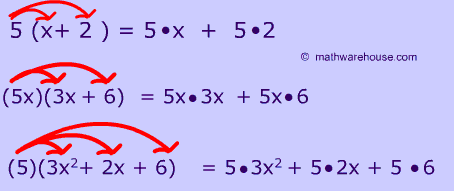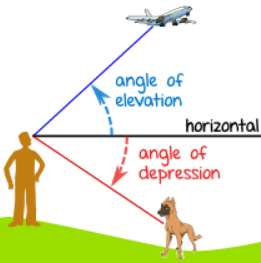In Chapter 5, I learned about Polynomial Operations
 Lesson 1 was review and a preview into the chapter. We reviewed what a variable and what an algebraic expression is. We also learned the difference between a monomial, binomial, trinomial, and a polynomial. (shown in image). With these polynomials, you can classify them by degree. “The degree of a monomial is the sum of the exponents of its variable(s)” and “the degree of a polynomial is the degree of the term with the highest degree.” After we learned how degrees work, we started to add and subtract polynomials. At first, with algebra tiles, then, just algebraically.
Lesson 1 was review and a preview into the chapter. We reviewed what a variable and what an algebraic expression is. We also learned the difference between a monomial, binomial, trinomial, and a polynomial. (shown in image). With these polynomials, you can classify them by degree. “The degree of a monomial is the sum of the exponents of its variable(s)” and “the degree of a polynomial is the degree of the term with the highest degree.” After we learned how degrees work, we started to add and subtract polynomials. At first, with algebra tiles, then, just algebraically.
Lesson 2 taught us how to multiply a polynomial by a monomial. Again, we used algebra tiles at first but then we learned how to expand an expression using the distributive property. The distributive property is a(b+c) = ab +ac. (examples shown in image below).
 In lesson 3, We expanded on what we knew and learned how to multiply two binomials together. In this lesson, there were two models, algebra tiles and an area diagram, however I prefer to solve algebraically. Again, we expanded on the distributive property concept. The distributive property for two binomials is as follows: (a+b)(c+d) = a (c+d) b (c+d)= ac +ad +bc +bd.
In lesson 3, We expanded on what we knew and learned how to multiply two binomials together. In this lesson, there were two models, algebra tiles and an area diagram, however I prefer to solve algebraically. Again, we expanded on the distributive property concept. The distributive property for two binomials is as follows: (a+b)(c+d) = a (c+d) b (c+d)= ac +ad +bc +bd.
I learned to use the acronym FOIL to help remember which terms to multiply first
F- First term in each bracket
O- Outside terms
I- Inside terms
L- Last terms in each bracket
In lesson 4, we practised the FOIL method and multiplied polynomials together. This continued in Lesson 5, and we were introduced problem solving by multiplication of polynomials and went more in depth with this in lesson 6.
In Chapter 4 I learned about Trigonometry.
In lesson 1, I learned about the Trigonometric Ratios. The three ratios are Sine (opposite over hypotenuse), Cosine (adjacent over hypotenuse), and Tangent (opposite over adjacent). I also learned about SOH COH TOA, and what it means. SOH represents the sine ratio, COH represents the cosine ratio, and TOA represents the tangent ratio.
In lesson 2, I learned how to use a calculator to solve trig ratios. When given the ratio, I need to find the angle and vice versa, to do this we use the inverse operations of said ratio.
In lesson 3, I learned how to calculate the length of a side in a right triangle and how to cross multiply to solve.
In lesson 4, I learned how to calculate the measure of an  angle in a right triangle. In order to do this, you need to know at least two side lengths of the triangle. And then you use a trig ratio (SOH CAH TOA) and plug in the numbers to solve. I also learned about the angle of elevation and the angle of depression. (Image shown). The angle of elevation is measured upwards from the horizontal line, while the angle of depression is measured downwards from the horizontal line. I learned how to apply this knowledge to solve word problems.
angle in a right triangle. In order to do this, you need to know at least two side lengths of the triangle. And then you use a trig ratio (SOH CAH TOA) and plug in the numbers to solve. I also learned about the angle of elevation and the angle of depression. (Image shown). The angle of elevation is measured upwards from the horizontal line, while the angle of depression is measured downwards from the horizontal line. I learned how to apply this knowledge to solve word problems.
In lesson 5, we reviewed and practised solving right triangles. Depending on the information that was given for each example, we used the Pythagorean Theorem, Trig, or both.
In lesson 6, problem solving was introduced and I learned how to solve them using the trigonometric ratios. I also learned about Bearings which are angles measured clockwise from the north direction and they were also included in the word problems.
And lastly, lesson 7 was more practice and problem solving using trig ratios. These questions were little more complicated and we started solving problems with three dimensional shapes.
Here is my presentation about this app:
Science App Review
 Lesson 1 was review and a preview into the chapter. We reviewed what a variable and what an algebraic expression is. We also learned the difference between a monomial, binomial, trinomial, and a polynomial. (shown in image). With these polynomials, you can classify them by degree. “The degree of a monomial is the sum of the exponents of its variable(s)” and “the degree of a polynomial is the degree of the term with the highest degree.” After we learned how degrees work, we started to add and subtract polynomials. At first, with algebra tiles, then, just algebraically.
Lesson 1 was review and a preview into the chapter. We reviewed what a variable and what an algebraic expression is. We also learned the difference between a monomial, binomial, trinomial, and a polynomial. (shown in image). With these polynomials, you can classify them by degree. “The degree of a monomial is the sum of the exponents of its variable(s)” and “the degree of a polynomial is the degree of the term with the highest degree.” After we learned how degrees work, we started to add and subtract polynomials. At first, with algebra tiles, then, just algebraically. In lesson 3, We expanded on what we knew and learned how to multiply two binomials together. In this lesson, there were two models, algebra tiles and an area diagram, however I prefer to solve algebraically. Again, we expanded on the distributive property concept. The distributive property for two binomials is as follows: (a+b)(c+d) = a (c+d) b (c+d)= ac +ad +bc +bd.
In lesson 3, We expanded on what we knew and learned how to multiply two binomials together. In this lesson, there were two models, algebra tiles and an area diagram, however I prefer to solve algebraically. Again, we expanded on the distributive property concept. The distributive property for two binomials is as follows: (a+b)(c+d) = a (c+d) b (c+d)= ac +ad +bc +bd. angle in a right triangle. In order to do this, you need to know at least two side lengths of the triangle. And then you use a trig ratio (SOH CAH TOA) and plug in the numbers to solve. I also learned about the angle of elevation and the angle of depression. (Image shown). The angle of elevation is measured upwards from the horizontal line, while the angle of depression is measured downwards from the horizontal line. I learned how to apply this knowledge to solve word problems.
angle in a right triangle. In order to do this, you need to know at least two side lengths of the triangle. And then you use a trig ratio (SOH CAH TOA) and plug in the numbers to solve. I also learned about the angle of elevation and the angle of depression. (Image shown). The angle of elevation is measured upwards from the horizontal line, while the angle of depression is measured downwards from the horizontal line. I learned how to apply this knowledge to solve word problems.